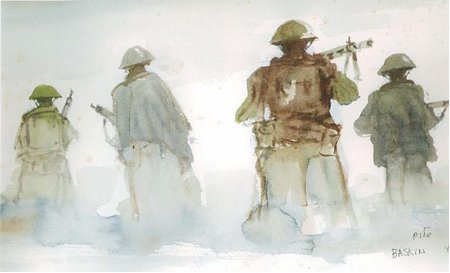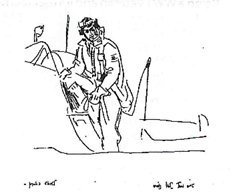One of the best-kept secrets of the War of Independence is that Machal and other fighters were recorded for posterity in sketches drawn by several artists. Among the artists were two Machalniks, as well as Israel’s internationally renowned Nachum Gutman.
South African volunteer Edal Marcus began his Israel Air Force career in July 1948 as a radio operator with 103 Squadron at Ramat David. On the 29th of that month he made a pastel drawing of me, which still adorns a corner of my living room wall. Marcus was appointed official IAF war artist soon after the powers-that-be at Air Force Headquarters learned of his artistic talents.
To the best of my knowledge, none of Marcus’s drawings have ever been exhibited publicly and most are probably gathering dust in some IDF Archives storeroom. I can visualize one he made at Sdom which captures beautifully its isolation in the rich red and brown shades of adjacent barren hills. As will be recalled, Sdom, whose airstrip was the world’s lowest at 1,300 feet below sea level, was then accessible only by air and linked to mainland Israel by night and day supply runs of the IAF’s DC-3, Norseman and DH Rapide transport airplanes.
Another Marcus drawing that comes to mind is one he did in March 1949 at the Avraham airstrip in the wake of “Operation Fact.” In this last and only bloodless campaign of the War of Independence, the IDF occupied all Negev territory up to Um Rash-Rash, site of today’s Eilat, that had been allotted to Israel under the historic UN Partition Plan of Palestine. It shows a DC-3 being unloaded of its cargo in the heart of the desert.
The other Machalnik I know of who drew War of Independence scenes back then was Sol Baskin of the U.S.A., who in World War II rose in the field from private to officer in the U.S. Fifth Army’s 34th Infantry Division through the Italian campaigns. In 1948/49 he was with the IDF’s Alexandroni Brigade, first as a platoon commander and finally as commander of its 37th Battalion. He stayed on in Israel after 1948, and served in a combat capacity in its later wars. Many battle scenes depicted in Baskin’s sketches from Italy in 1943 to the Yom Kippur War in 1973 were done from “up front,” not as an official war artist but on his own initiative as a labor of love. His sketches often appeared in the U.S. Army newspaper “Stars and Stripes.” Sol Baskin is still active as one of Israel’s leading artists and sculptors.

I was pleasantly surprised to discover earlier this year that Nachum Gutman was also a war artist of the War of Independence. Gutman was then in his fifties, and already well-known for his paintings and drawings which faithfully record both early Tel Aviv and the Yishuv in general.
Being a World War II veteran and former member of the Jewish Legion probably helped Gutman capture the spirit of the times in his War of Independence drawings. Many of these drawings showing on-duty soldiers, sailors and airmen appeared in his 1950s book “So They Were,” in which he wrote with admiration of their high morale and determination. A selection of those nostalgia-evoking ink drawings are now on display, until September, at Tel-Aviv’s Nachum Gutman Museum in a special exhibited also called “So They Were.”

Some months prior to the opening of the exhibit, the museum’s director Yoav Dagon made a concerted effort to determine the identities of the people depicted in Gutman’s sketches. Three subjects in four “air force” drawings had been identified when he enlisted my help. Easily recognizable in two drawings is fighter pilot Rudy Augarten of the U.S.A., as is his comrade-in-arms, Ezer Weizman, in another drawing. The fourth depicts retired El Al captain Oded Abarbanel when he was an IAF light-plane pilot.
Reliance on memory and comparisons with photos yielded only several possible and one positive identification, that of South Africa’s pioneer Machal pilot Boris Senior. I then enlisted the help of other former “first fliers” in Israel and overseas, among them the well-known South African Machal pilot Arieh “Kappy” Kaplan who was super-helpful. Thanks largely to their collective input, names have been added to all the ten Gutman drawings I dealt with. Besides Rudy Augarten, positive Machal identifications include Bill Schroeder, “Slick” Goodlin and Leo Nomis of the U.S.A., Arnie Ruch and Jack “Tich” Isaacson of South Africa, Harold Caplan and Sandy Jacobs of Britain and Canada’s Denny Wilson.
The satisfaction I derived from this unusual research project is more than ample reward for the time and effort invested. Catalogues of the sketches “So They Were” are available from the Nachum Gutman Museum, 21 Rokach Street, Tel Aviv 65148, info@gutmanmuseum.co.il
Author: Eddy Kaplansky, June 2002, American Veterans of Israel Newsletter: Summer 2002

